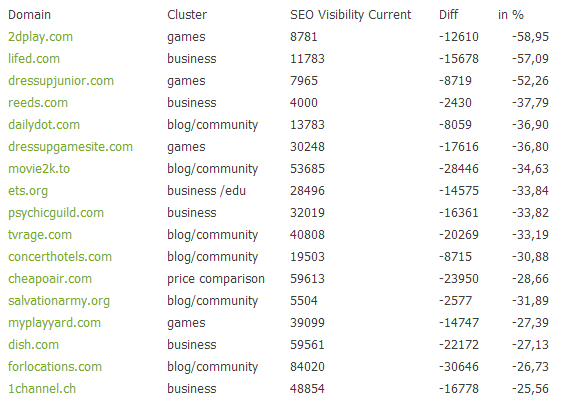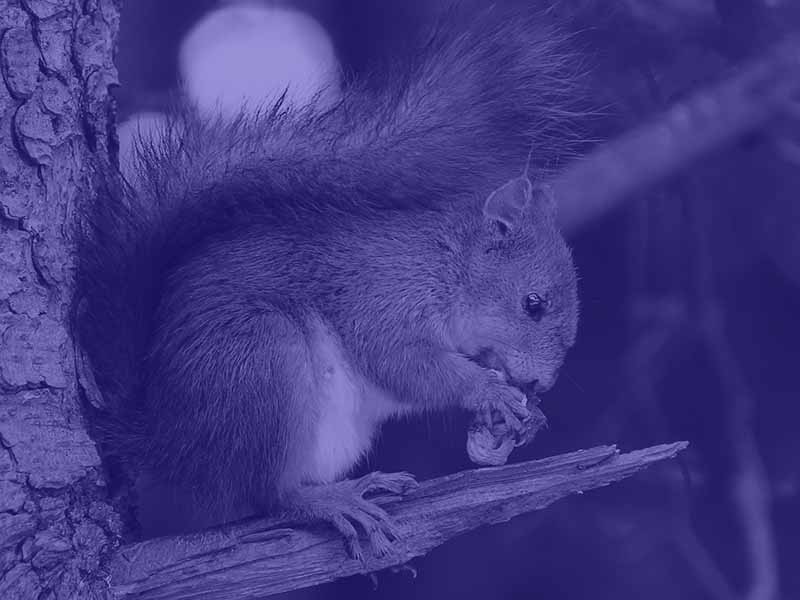On May 22, 2013, the latest major Google algorithm update, dubbed Penguin 2.0, impacted a large number of search results (2.3% of US-English queries vs. 3.1% for Penguin 1.0). But are there any major differences between the two updates that would suggest altering your strategy as a site or business owner?
Let’s take a look.
Pre-Penguin Info
Matt Cutts, head of Google’s Webspam team, announced the planned changes, but kept things customarily vague in the video. He did say that Penguin 2.0 would be more comprehensive and go deeper than Penguin 1.0. He specifically called out advertorials that attempt to pass PageRank without disclosure as something Google was going to look at with greater scrutiny. So what happened?
Initial Shocks
The day after the Penguin 2.0 update was rolled out, Searchmetrics provided a snapshot view of some of the sites that were hit the hardest.

A couple of broad observations here:
- The author suggested that sites hit by Penguin 2.0 exhibited some untrustworthy links and potentially some thin content.
- For many of these sites, the ranking drop was more of a correction than a penalisation. For example, SalvationArmy.org had an unexplainable spike in search visibility the week prior to Penguin 2.0, and went back to normal levels when Penguin hit. Others like Dish.com were hit by Penguin 2.0, but bounced right back up to previously high levels the following week. Sites like Cheapoair.com were definitely hit by almost 40% with no signs of recovery.
Deeper Analysis
One of the sites hit hard in the Searchmetrics report, Cheapoair.com, was analyzed in-depth to see what might explain the Penguin slam. In this particular case, the drop could be due to:
- Overdone exact-match anchor text. 66 percent of their backlinks used an exact link anchor, such as “cheap flights,” which was very unnatural compared to competitors, which averaged around 20-30%.
- Links from 148 pages that aren’t indexed anymore in Google, and links from 24 sites reportedly containing malware.
- Other unnatural signals for the industry. Compared to competitors, Cheapo had a much higher percentage of backlinks from other travel sites (65% vs. 30%) and higher quality distribution of links compared to the competition. It’s probably not smart to say “good is bad” because of this (especially since the other items found probably had a much greater contribution to the penalty), but in the absence of any other questionable signals, I suppose “unnatural” link profiles–even if they’re unnaturally good–could be an explanation.
Another analysis of sites hit by Penguin 2.0 suggests that the algorithm change really was “deeper” as Matt Cutts had promised. Essentially, Penguin 1.0 focused on unnaturally backlink anchor text profiles pointing at the home page and this was rolled out to cover deep pages as well with Penguin 2. So if you have product or category pages with an abundance of exact match anchor text links, there’s a good possibility that Google cracked down on you (or will soon).
There’s also some good evidence that Google used Penguin 2.0 to process link disavow requests. Based on what we’re seeing, this could result in an increase in rankings, if the disavowal of links occurred as the result of a penalization and included a reconsideration request. On the other hand, if site owners used the link disavow tool more as a precautionary measure without an immediate need, then rankings dropped, as in the case of Cyrus Shepard’s kamikaze test linked to above.
A large number of queries may have been effected, but if the effects were largely felt by rankings on the 2nd or 3rd page (or deeper), as some studies suggest, then site owners may not see many real traffic changes.
Quick Summary of Penguin 2.0 Results
Here are the main points:
- Penguin 2.0 may have impacted as many search queries as Penguin 1.0 did, but it doesn’t mean that site owners will necessarily feel the impact as much, since Penguin 2.0 seems to be having a bigger effect on results further down the SERPs.
- Penguin 2.0 was largely a continuation of the first Penguin update. Unnatural link sources and link anchor text are still being targeted. There’s a good chance that those hit by Penguin 1 due to unnatural home page links also got hit by Penguin 2 because of unnatural deep page links, assuming they didn’t make efforts to eliminate questionable links through manual removal or disavow tools. Be forewarned – doing link removal before an actual penalty, while good-intentioned, may cause a traffic dip in the short-term.
- We’re not necessarily seeing new types of links being penalized in Penguin 2.0 (at least none that have been publicly admitted so far).
- Penguin 2.0 provides more evidence that Google shapes search results by industry and the players in that industry. “Unnatural” to Google is anything that deviates too much from typical backlink and anchor text distributions within a particular industry. If you’re currently engaged in link building, it’s critical to understand what is “normal” for your industry and competition.
Google algorithm changes are starting to feel a lot like natural disasters: initial widespread panic by some, “wait-and-see” by others, assessing the damage, totalling up the casualties. Some rush to make a recovery plan before knowing what’s damaged, what’s actually needed, and how long it’ll take to fix. Others wait around for somebody else to tell them what to do. Those hit hardest are often the ones who aren’t working closely enough with their SEO team to ensure quality content development and link building.
